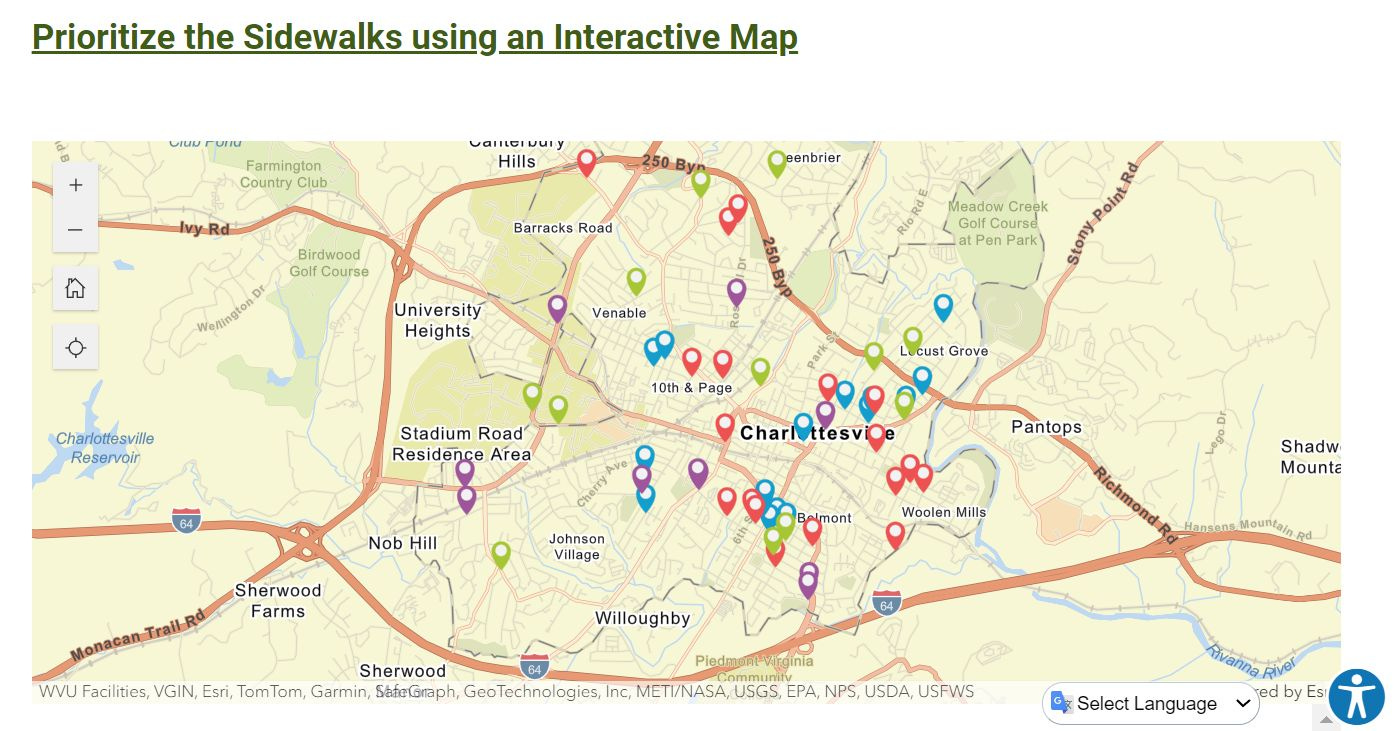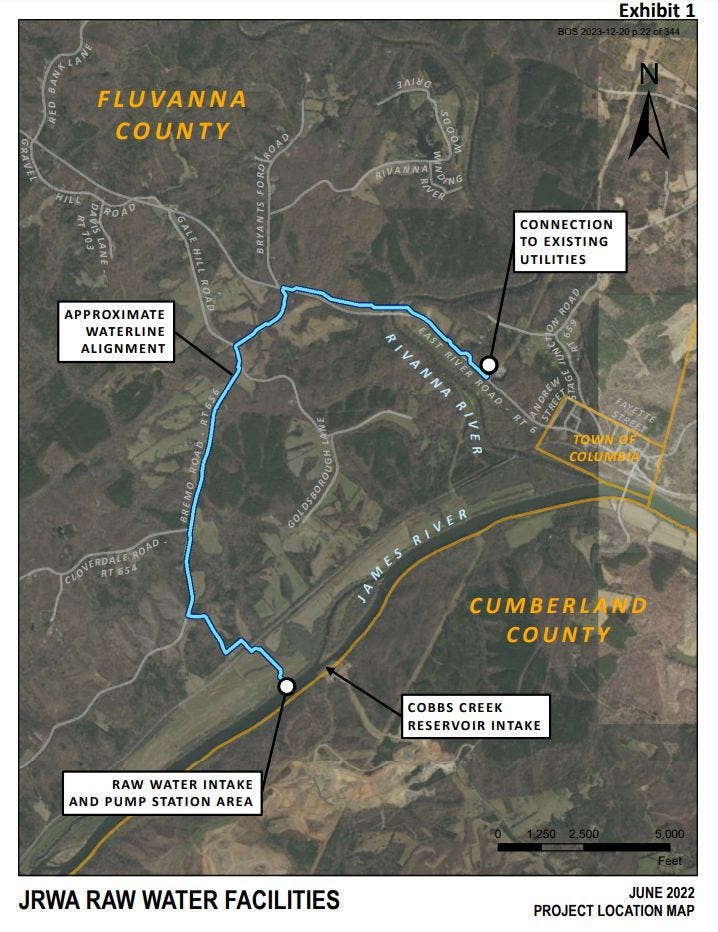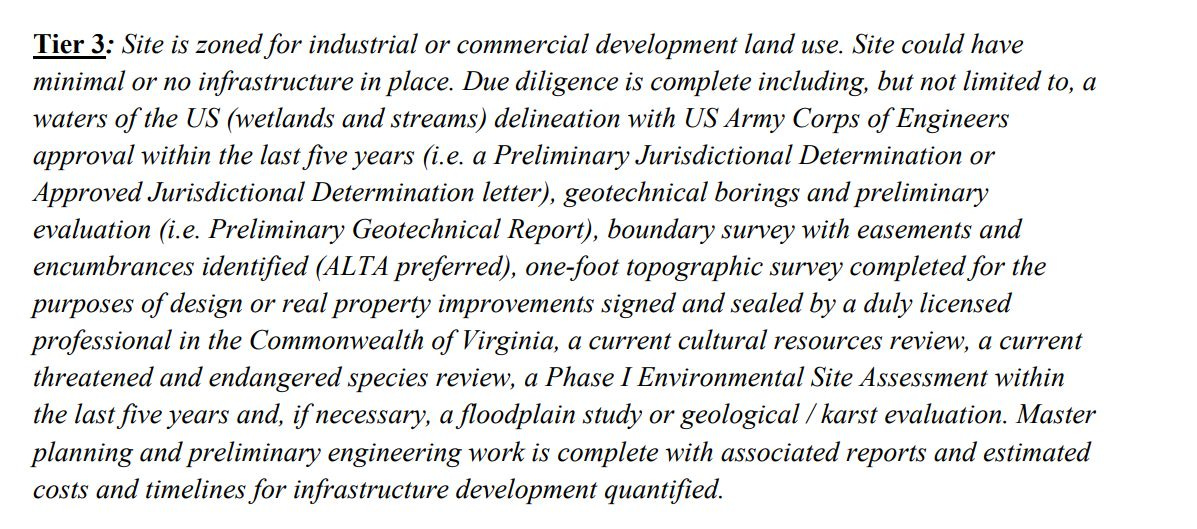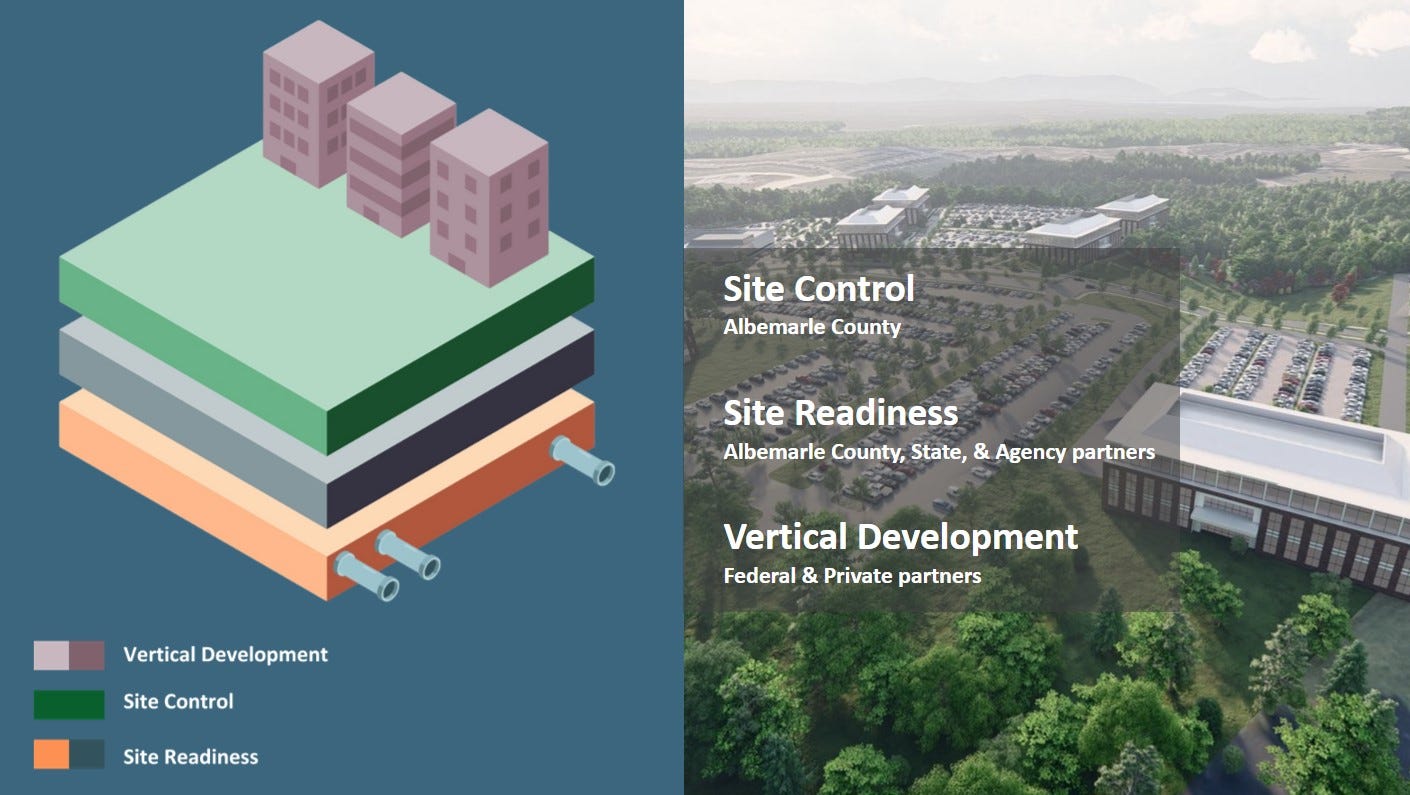April 25, 2024: Charlottesville seeks input on sidewalk priorities; Albemarle's own rezoning for Rivanna Futures is on the fast track
Plus: Tammy Purcell reports on a key milestone for the James River Water Project
Twelve years ago today, opponents of the Meadowcreek Parkway had their day in federal court to argue that the project had been illegally segmented in order to evade federal scrutiny. I wrote so many stories about all of that a long time ago, but only remembered because I looked up April 25 on cvillepedia. I’m Sean Tubbs, and I needed some way to open up this edition of Charlottesville Community Engagement.
On today’s edition:
Charlottesville is seeking comments on a draft sidewalk priority list
The U.S. Army Corps of Engineer has approved a permit to allow water to be drawn from the James River for use in Zion Crossroads
A rezoning and special use permit that Albemarle County is seeking for its own property will go before the Planning Commission on May 14, less than two months after the application was filed
Fans of large puppets may want to check out tomorrow’s Festival of the Moving Creature at the University of Virginia
First shout out: Piedmont Master Gardeners seek items for Green Elephant sale
In today’s first subscriber supported public service announcement: If you are cleaning out your garage, basement or garden shed as spring approaches, the Piedmont Master Gardeners will gladly take any yard and garden equipment you no longer need.
PMG is now accepting donations of new and used tools, hoses, decorative items, outdoor furniture—virtually anything used to create, maintain and enjoy a garden. These “Green Elephants” will be offered for sale to the public during PMG’s Spring Plant Sale. Donated items may be dropped off at 402 Albemarle Square between 10 a.m. and noon on Tuesdays and Saturdays through the end of April. PMG is not able to accept plastic pots or opened chemicals. To arrange a pickup or for more information, contact the Piedmont Master Gardeners at greenelephant@piedmontmastergardeners.org.
As for that sale? Mark your calendar for Saturday, May 4, at Albemarle Square Shopping Center.
Charlottesville seeking feedback on sidewalk priority list
We are in an era now where the City of Charlottesville’s Public Works Department has begun filling in some of the many gaps where there aren’t sidewalks. Recently completed sections include a portion of East High Street, a section of Elliott Avenue and in the Fifeville neighborhood a ten-foot stretch of asphalt that completes a pathway to Forest Hills Park.
With several projects under the city’s belt, both Public Works and the Department of Neighborhood Development Services are working to finalize a priority list.
“City staff… has drawn from previous plans and studies, including the Bicycle and Pedestrian Master Plan, the Streets That Work Design Guidelines, and several small area plans completed since 2015,” reads a city website to gather feedback on the work so far.
The city has long struggled to build sidewalks or implement large transportation projects despite a lot of planning.
Charlottesville City Council adopted the Bicycle and Pedestrian Master Plan on September 8, 2015 followed a year later by the Street That Work Plan. That was an era when it seemed there was an endless appetite to hire consultants to do planning, but not a lot of construction. For example, a company called the Toole Design Group got paid $190,000 for their work on both projects. The same firm would go on to be paid at least $199,987 to create a Standards and Design Manual.
After the summer of 2017, the city went through a string of city managers and different City Councilors and city personnel, and institutional knowledge was lost. Sam Sanders arrived as Deputy City Manager in July 2021 and was assigned the task of restructuring how transportation projects are managed. Using a grant from the Virginia Department of Transportation, the city’s existing sidewalk priorities were reviewed to take connectivity, safety, suitability, and demand.
Another factor is equity.
“The provision of sidewalks in Charlottesville has not always been done in an equitable manner,” reads the website. “Like many other investments in our community, there is an alignment between areas where infrastructure investments like sidewalks are needed and areas where populations of non-white, low-income, youth, elderly, disabled, or having limited English proficiency live.”
The city is seeking comment on April 30 on priorities. The information is available in the form of an interactive map as well as an Excel spreadsheet. People are asked to provide their comments.
In addition to building some stretches of sidewalk, city transportation planners also provided an update last year on the Bicycle and Pedestrian Master Plan. (take a look)

James River Water Project gets permit from Army Corps of Engineers
(The following story is from Engage Louisa by Tammy Purcell and is reprinted with permission. Please visit her site for the most thorough information about Louisa County)
A long-awaited water line linking the James River to Ferncliff took a major step forward last week.
The James River Water Authority, a joint endeavor between Louisa and Fluvanna counties, on Monday received a key permit from the Army Corps of Engineers (COE), clearing the way for construction of the James River Water Project.
The project, which has been more than a decade in the making and riddled with controversy and delays, includes a raw water intake and pump station on the banks of the James and a four-mile stretch of pipeline to connect it to an existing water main just north of Route 6 in southern Fluvanna.
When complete—likely by the spring of 2027—the infrastructure will enable JRWA to pull millions of gallons of raw water from the river, which will be channeled to a water treatment plant at Ferncliff and, for Louisa County’s purposes, on to development at Ferncliff, Zion Crossroads and Shannon Hill.
The water line will relieve Louisa of its dependence on a handful of publicly owned wells, which have supported commercial and residential growth at Zion for more than two decades. It will also supply the water necessary to develop the Shannon Hill Regional Business Park.
The project is expected to cost $45.6 million, split between Louisa and Fluvanna. Louisa has already spent some $40 million on the Ferncliff treatment plant and a 13-mile stretch of water line across Fluvanna. Both have sat idle as JRWA has struggled to secure the permits necessary to complete its portion of the infrastructure.
County Administrator Christian Goodwin and JRWA Chairman D.D. Watson, who serves as Louisa’s citizen representative on the authority’s board, welcomed the news that the Corps had cleared the way for the project’s construction.
“The permit is a significant milestone in the years of responsible effort by the JRWA to ensure that our region can rely on a much-needed and sustainable source of water for citizens,” Goodwin said in an email. “We enjoy a strong relationship with our neighbors in Fluvanna and look forward to completing the project with them.”
Watson said that both counties had put in considerable work to obtain the permit and he’s excited to see the project move forward.
“Everybody is so elated because it [took] so long and every corner we turned it was one more thing we needed, one more thing we needed,” Watson said. “You can’t make much of a move without the Corps of Engineers signing off on it, so once they did, we are ready to take the next step.”
In securing the Corps’ approval, JRWA cleared a hurdle that has stalled the project for at least six years. In 2018, the authority applied to build the intake and pump station at the confluence of the James and Rivanna rivers—a site that’s believed to be Rassawek, the ancestral capital of the Monacan Indian Nation. JRWA officials said they chose the site largely because it was the cheapest place to build the infrastructure.
But the Monacan staunchly opposed the location, citing concerns that their ancestors are buried in the area. The tribe’s resistance stymied the permitting process and, four years later, prompted the authority to move the intake and pump station to a new location about two miles upstream and reroute the pipeline to connect to it. In August of 2022, JRWA applied for a COE permit at the new site with the support of the Monacan.
Though the authority agreed to relocate the project to avoid a site sacred to the Monacan, it could still impact other historic and cultural resources including archeological sites connected to the tribe, who lived along the river for centuries prior to English settlement, and remnants of the James River and Kanawha Canal, a canal system that dates to the late 18th and early 19th century.

JRWA, the Monacan, the Virginia Department of Historic Resources and other stakeholders spent the last several months crafting a plan to mitigate the project’s impact. On April 8, the groups inked a Memorandum of Agreement, which provides a roadmap for how the project must proceed with respect to cultural and historic sites. The agreement cleared the way for the COE to issue its permit.
Watson said that the authority has built a strong relationship with the Monacan after agreeing to construct the intake and pump station at the new site.
“I think we did the right thing. [The Monacan] are now happy. We are now happy. I think our relationship is better because we made the decision to compromise,” he said.
With the COE permit in hand, the authority is poised to begin a lengthy construction process, which requires careful choreography to balance ongoing archeological work and federal restrictions aimed at protecting wildlife.
US Fish and Wildlife Service regulations, implemented to protect the habitat of the endangered Northern Long-Eared Bat, prohibit JRWA from tree-clearing between April 1 and November 14. The service also places limits on when work can be done in the riverbed, restricting access after mussel surveys are conducted.
“Work is expected to begin in the next few weeks on portions of the project that are not subject to remaining archeological work or species-related time-of-year restrictions,” Goodwin said. “The construction schedule has been phased to efficiently incorporate any timing constraints necessitated by the permits.”
Goodwin added that the authority is “in the final stages of obtaining a few remaining local and state approvals,” which it expects to receive in the next couple weeks. Fluvanna County Administrator Eric Dahl told his Board of Supervisors at its March 6 meeting that JRWA still needs an erosion and sediment control permit from Fluvanna County and a stormwater management permit from the Virginia Department of Environmental Quality.
JRWA and Louisa County expect water to flow to Ferncliff and beyond by April 2027.
Visit Engage Louisa to stay on top of what’s happening in the easternmost locality in the Thomas Jefferson Planning District.
Sponsored message: Buy Local
From Crozet to Barracks Road, the Downtown Mall to the Shops at Stonefield, and everywhere in between, Albemarle County and Charlottesville’s Offices of Economic Development encourage you to Buy Local as spring approaches.
Buying locally supports our neighbors and community members and makes a big impact for our local economy. Local businesses are more likely to reinvest in our community and their goods and services contribute to the unique character of our community.
Learn more about how you can support local business at ShowLocalLove.org and on social media:
Albemarle fast-tracking development review for its own rezoning application for Rivanna Futures
Albemarle County has moved fast in the eleven months since officials announced they had been working on a plan to pay $58 million to buy 462 acres of land around the Rivanna Station to both protect the military base from encroachment and build a new business park.
“We closed in December but the work hasn’t stopped,” said Deputy County Executive Trevor Henry at the April 17, 2024 meeting of the Board of Supervisors. “As we said last fall, there are things we needed to do just to get the property zoned appropriately.”
Albemarle wants to build something called the Intelligence and National Security Innovation Acceleration Campus and is lobbying the federal and state government for funding and to become partners. In late March, Albemarle submitted applications through its own Community Development Department for a rezoning as well as a special use permit. (read my C-Ville Weekly story)
“This work, and I’ll thank the Board again for this action, because it has created a buzz in the intelligence community and we’ve had some outreach to us in a pretty meaningful way in the last quarter or so,” Henry said.

Rivanna Station itself is not an independent military base and Henry said the U.S. Army is currently expanding on the site.
“Fort Belvoir is the property owner and technically this is a sub-installation of Fort Belvoir and it comprises 75 acres,” Henry said. “Nearly fully built out with this last addition that is happening.”
Already Albemarle County is deriving revenue from the property after assuming control of a lease for a parking lot with the U.S. Army.
“We get about just under $30,000 a month.” Henry said.
Henry said the rezoning is necessary to help qualify for economic development opportunities that may be available. He said the county wants to bring the property up to Tier 4 readiness as classified by the Virginia Economic Development Partnership.
“Just getting us consistently zoned will get us to Tier 3 which is meaningful,” Henry said.

Henry said after the rezoning, the county would hire another consultant to develop a master plan to provide details for the intelligence and defense sector campus. This firm would be one that does this kind of work on a routine basis and said this could lead to another rezoning as more details are known.
Michael Barnes is the relatively new Planning Director for Albemarle County and he had more details about the rezoning.
“This rezoning is to a [Light Industrial] with a special use permit for office uses,” Barnes said. “This first supports the light manufacturing and office uses that are envisioned by the project.”
When the rezoning is complete, Albemarle can ask the Virginia Economic Development Partnership for more funding to help get to Tier 4.
“We’re trying to push this through quickly in large part to be eligible for the grant,” Barnes said. “We hope to get to the Planning Commission in May, to [the Board of Supervisors] in June, June 12, so that we’ll be ready this summer for this grant application.”
To make that schedule work, Albemarle is condensing some of the steps.
Section 33.4.K of the county’s ordinance requires developers to conduct a community meeting to provide information to the public about the application as well give people the opportunity to ask questions.
The county’s director of zoning has the ability to waive to community meetings under 33.4.K.2. Otherwise, 33.4.K.6 states when these are to occur.
“A community meeting will be held prior to the first public hearing on the application for a zoning map amendment,” reads that section of the code.
There was no mention of a community meeting during the Supervisors discussion, but the Free Enterprise Forum confirmed one would be held at the Places29-North Community Advisory Committee scheduled for May 9.
The Planning Commission is expected to hold its public hearing on May 14.

Toward the end of the discussion, Supervisor Chair Jim Andrews said he was excited about the project.
“The development will go through a lot of the same processes that private development has gone through,” Andrews said.
However, Andrews said the rezoning has to come with a impact statement that analyzes the effects on school population, road congestion, and other effects that come with large development.
Neil Williamson of the Free Enterprise Forum has a long post about the appearance that this development is getting special treatment, noting that other projects are not fast-tracked and require more information than Albemarle is providing.
“We are encouraged that Albemarle County may be in the process of proving, if they want to, they can get an application approved quickly,” Williamson wrote.
Take a look at Williamson’s comments and see what you think.
In other information, this afternoon, the Chamber of Commerce’s Defense Affairs Committee hosted a public meeting about the annual Threat Assessment that’s issued by the Office of the Director of National Intelligence. (meeting info)
The latest Threat Assessment is dated February 5, 2024 and can be downloaded here.
Festival of the Moving Creature to roam UVA Grounds tomorrow
Tomorrow evening, the University of Virginia’s Arts Grounds will be home to the SW2 Festival of the Moving Creature.
This highly anticipated event promises an unforgettable experience, featuring two gigantic mythical creatures parading through the UVA Grounds, brought to life by the talented students, faculty, and staff of the Art of the Moving Creature drama department class,” reads an article on the UVA Arts web page.
The festival is named for two people. The late Stan Winston is a special effects legend who also graduated from the University of Virginia. Steven Warner is an assistant professor at UVA Drama and co-founder of the event.
The parade will begin at 7 p.m. at the UVA Arts Grounds on Culbreth Road. Creatures and their handlers will head to the Rotunda at Sunset to take advantage of the golden hour of light. A dance party will take place when the creatures are home.
For previews, check out the Instagram feed and the Facebook page.
Learn more about the event on the UVA School of Architecture website with an interview with Melissa Goldman, the Fabrication Lab Manager at the school and a lead instructor on the course.
Reading material:
Louisa’s Straley named state’s top superintendent, John Hajduk lll, The Central Virginian, April 23, 2024
Charlottesville making strides to end affordable housing crisis, city Realtors, developers and employees agree, Hawes Spencer, Charlottesville Daily Progress (paywall), April 23, 2024
CBS19 takes a tour of Albemarle County's new Public Safety Operations Center, Garrett Whitton, April 24, 2024
Albemarle County to rename Agnor-Hurt Elementary School despite pushback, Emily Hemphill, Charlottesville Daily Progress (paywall), April 25, 2024
FCC reinstates net neutrality rules, Chris Teale, Route 50, April 25, 2024
#670 is plenty to do in one day
This is the first installment to feature an article from someone else. I first got the news of the U.S. Army Corps of Engineers permit from Tammy Purcell and was going to do my own research. Instead I asked her for permission to see if I could write something up and I’m pleased to be able to bring you information someone else wrote.
In the future, there will be much more of this as I figure out how to find people who want to cover specific items. There’s more than enough in this community to write about, and for four years I’ve been building up an engine.
And, that is all work paid for by subscribers and a few sponsors. I thanked a dozen people last night for their paid subscription and you’ll get yours if you opt to sign up at either $5 a month level, the $50 a year level, or the $200 a year level. Or more! For those first three, though, Ting will match your initial payment. They do because they are also about community.
Ting can help you with your high speed Internet needs. If service is available in your area and you sign up for service, enter the promo code COMMUNITY and you will get:
Free installation
A second month for free
A $75 gift card to the Downtown Mall








This was published with an incorrect date. As far as I know, it's still 2024. 2025 is not for another 251 days. I regret the error and ignoring the voice in my head that said "Please check one more time before you publish!"